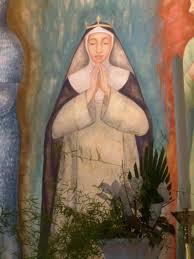St. Margaret of Hungary (1242-1271)

Margaret, the daughter of King Bela IV of Hungary, was offered to God before her birth, in petition that the country would be delivered from the terrible scourge of the Tartars. The prayer having been answered, the king and queen made good their promise by placing the little girl in the Dominican convent at Vesprim. Margaret was three years old. Here, in company with other children of the nobility, she was trained in the arts thought fitting for royalty.
Margaret was not content with simply living in the house of God; she demanded the religious habit and received it at the age of four. Furthermore, she took upon herself the austerities practiced by the other sisters fasting, hairshirts, the discipline, and night vigils. She soon learned the Divine Office by heart and chanted it happily to herself as she went about her play. No one but Margaret seemed to take seriously the idea that she would one day make profession and remain as a sister, for it would be of great advantage to her father if she were to make a wise marriage.
This question arose seriously when Margaret was twelve. She responded in surprise. She said that she had been dedicated to God, even before her birth, and that she intended to remain faithful to that promise. To settle the matter, she pronounced her vows to the master general of the Order, Humbert of the Romans. Again, when Margaret was eighteen, her father made an attempt to swerve her from her purpose, because the king of Bohemia had come seeking her hand. He even obtained a dispensation from the pope and approached Margaret with the permission. Margaret replied as she had previously, "I esteem infinitely more the King of Heaven and the inconceivable happiness of possessing Jesus Christ than the crown offered me by the king of Bohemia." Having established that she was not interested in any throne but a heavenly one, she proceeded with great joy to live an even more fervent religious life than she had before.
Margaret's royal parentage was, of course, a matter of discussion in the convent, but the princess managed to turn such conversation away from herself to the holy lives of the saints who were related to her by blood St. Stephen, the king, St. Hedwig, St. Elizabeth of Hungary, and several others. She did not glory in her wealth or parentage, but strove to imitate the saints in their holiness. She took her turn in the kitchen and laundry, seeking by choice much heavy work that her rank might have excused her from doing. She was especially welcome in the infirmary, which proves that she was not a sad faced saint, and she made it her special duty to care for those who were too disagreeable for anyone else to tend.
Margaret's austerities seem excessive to us of a weaker age. The mysteries of the Passion were very real to her and gave reason for her long fasts, severe scourgings, and other mortifications. She had a tender devotion to Our Lady, and on the eve of her feasts, Margaret said a thousand Aves.
Unable to make the long pilgrimage to the Holy Land, to Rome, or to any of the other famous shrines of Christendom, the saint developed a plan by which she could go in spirit: she counted up the miles that lay between herself and the desired shrine, and then said an Ave for every mile there and back. On Good Friday she was so overcome at the thoughts of our Lord's passion that she wept all day. She was frequently in ecstasy, and very embarrassed if anyone found her so and remarked on her holiness.
A number of miracles were performed during Margaret's lifetime and many more after her death. The island where her convent stood, called at first the "Blessed Virgin's Isle," was called "Isle of Margaret" after the saint. She is invoked against floods, in memory of a miracle she performed in stopping a flood on the Danube.
(Source : Dorcy, Marie Jean. St. Dominic's Family. Tan Books and Publishers, 1983)

Comments